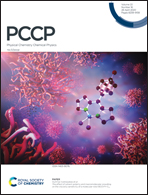Structure and C⋯N tetrel-bonding of the isopropylamine–CO2 complex studied by microwave spectroscopy and theoretical calculations†
Abstract
Tetrel-bonding emerges as a promising type of non-covalent interaction showing potential applications in molecular recognition and supramolecular chemistry. However, the molecular level characterization and interpretation of tetrel-bonds are still far from being satisfactory. In the present work, accurate structural and energetic information on the tetrel-bonds formed between CO2 and aliphatic amines is explored by means of high resolution rotational spectroscopy combined with quantum chemical calculations. The rotational spectrum of the isopropylamine–CO2 complex was investigated supersonic expansion. Two most stable isomers were observed, in which the isopropylamine moiety adopts trans and gauche forms, respectively. The relative abundance ratio of the two detected isomers was estimated to be NI/NII ≈ 5/1. The rotational spectra of the four 13C and one 15N mono-substituted isotopologues of the most stable isomer were also recorded and assigned, leading to an accurate determination of the backbone structure. The two moieties in both isomers are connected through a dominant C⋯N tetrel-bond and enhanced by one or two weak C–H⋯O hydrogen bonds. Natural bond orbital and quantum theory of atoms in molecules methods were utilized to quantitatively understand the characteristics of the non-covalent interactions. Symmetry-adapted perturbation theory analysis suggests that the electrostatic and dispersion interactions play a dominant role in stabilizing the titled complex.

- This article is part of the themed collection: 2020 PCCP HOT Articles


 Please wait while we load your content...
Please wait while we load your content...